托福听力lecture的结构知识讲解
- 格式:doc
- 大小:30.50 KB
- 文档页数:10

托福lecture怎么听-托福听力lecture常见技巧1.听好开头,抓到主题词,跟随教授思路,积极猜测要听好开头,我们就要熟悉教授开篇的说话套路,有这么几种:开门见山抛出话题,回忆上节课内容,或者引出的,比如用时代背景引出,用例子引出,用同学的提问引出的。
(1) 直接展开l today we are going to be talking about…l I’d like to begin my lecture by introducing…l let’s focus on…l let’s now take a look at…(2) 问答式展开l how are companies typically structured?l Do you remember what they are?l How can you understand it?l Why does human being consider it important?有时教授就是没说明今天要讲的内容,那就边听边确定主旨。
例如TPO20-6的生物学场景lecture,在文章的开头教授先提到the state of Maine,又提到那里的天气:snow,最后才说到adaptation(文章的主旨)。
其实只要我们清楚生物学场景的主要考点:动物、植物、生物科技相关话题。
就不难推断出文章真正的主旨,2. 剖析正文的常用结构,熟悉考点位置正文有不同的展开形式。
有教授的独角戏,有教授的大部分独白加上几处师生互动,也有通篇都是互动的讨论性讲座,只不过较少。
所以我建议把正文可以分出互动和独白的两个部分,来剖析结构。
1)互动部分:第一种结构是教授提问,主动权在教授手里,课堂还是沿着教授思路往后推动;第二种结构中同学的提问打断了教授的思路,教授要去回答同学的问题,改变了原有的思路,教授会沿着同学的提问内容展开。
2)独白部分,也就是教授一个人在讲述要点,讲座中往往有好几处独白,这些独白有一定的结构特征。
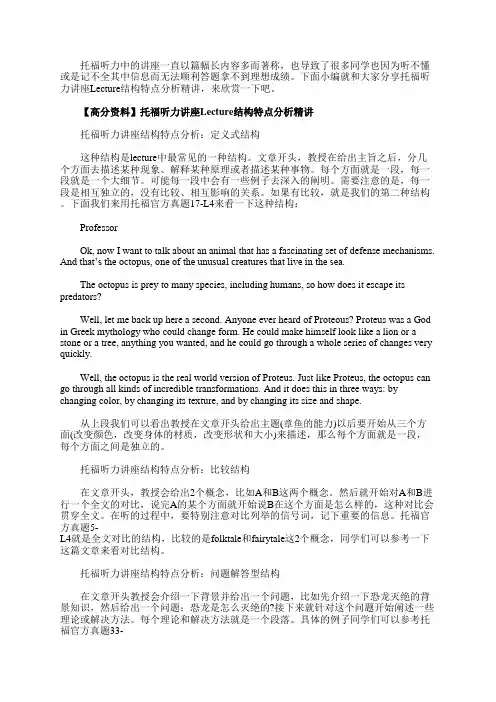
托福听力中的讲座一直以篇幅长内容多而著称,也导致了很多同学也因为听不懂或是记不全其中信息而无法顺利答题拿不到理想成绩。
下面小编就和大家分享托福听力讲座Lecture结构特点分析精讲,来欣赏一下吧。
【高分资料】托福听力讲座Lecture结构特点分析精讲托福听力讲座结构特点分析:定义式结构这种结构是lecture中最常见的一种结构。
文章开头,教授在给出主旨之后,分几个方面去描述某种现象、解释某种原理或者描述某种事物。
每个方面就是一段,每一段就是一个大细节。
可能每一段中会有一些例子去深入的阐明。
需要注意的是,每一段是相互独立的,没有比较、相互影响的关系。
如果有比较,就是我们的第二种结构。
下面我们来用托福官方真题17-L4来看一下这种结构:ProfessorOk, now I want to talk about an animal that has a fascinating set of defense mechanisms. And that’s the octopus, one of the unusual creatures that live in the sea.The octopus is prey to many species, including humans, so how does it escape its predators?Well, let me back up here a second. Anyone ever heard of Proteous? Proteus was a God in Greek mythology who could change form. He could make himself look like a lion or a stone or a tree, anything you wanted, and he could go through a whole series of changes very quickly.Well, the octopus is the real world version of Proteus. Just like Proteus, the octopus can go through all kinds of incredible transformations. And it does this in three ways: by changing color, by changing its texture, and by changing its size and shape.从上段我们可以看出教授在文章开头给出主题(章鱼的能力)以后要开始从三个方面(改变颜色,改变身体的材质,改变形状和大小)来描述,那么每个方面就是一段,每个方面之间是独立的。
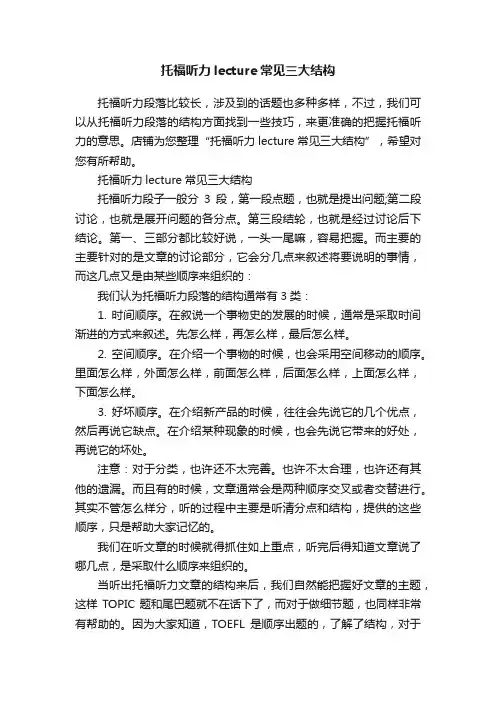
托福听力lecture常见三大结构托福听力段落比较长,涉及到的话题也多种多样,不过,我们可以从托福听力段落的结构方面找到一些技巧,来更准确的把握托福听力的意思。
店铺为您整理“托福听力lecture常见三大结构”,希望对您有所帮助。
托福听力lecture常见三大结构托福听力段子一般分3段,第一段点题,也就是提出问题;第二段讨论,也就是展开问题的各分点。
第三段结轮,也就是经过讨论后下结论。
第一、三部分都比较好说,一头一尾嘛,容易把握。
而主要的主要针对的是文章的讨论部分,它会分几点来叙述将要说明的事情,而这几点又是由某些顺序来组织的:我们认为托福听力段落的结构通常有3类:1. 时间顺序。
在叙说一个事物史的发展的时候,通常是采取时间渐进的方式来叙述。
先怎么样,再怎么样,最后怎么样。
2. 空间顺序。
在介绍一个事物的时候,也会采用空间移动的顺序。
里面怎么样,外面怎么样,前面怎么样,后面怎么样,上面怎么样,下面怎么样。
3. 好坏顺序。
在介绍新产品的时候,往往会先说它的几个优点,然后再说它缺点。
在介绍某种现象的时候,也会先说它带来的好处,再说它的坏处。
注意:对于分类,也许还不太完善。
也许不太合理,也许还有其他的遗漏。
而且有的时候,文章通常会是两种顺序交叉或者交替进行。
其实不管怎么样分,听的过程中主要是听清分点和结构,提供的这些顺序,只是帮助大家记忆的。
我们在听文章的时候就得抓住如上重点,听完后得知道文章说了哪几点,是采取什么顺序来组织的。
当听出托福听力文章的结构来后,我们自然能把握好文章的主题,这样TOPIC题和尾巴题就不在话下了,而对于做细节题,也同样非常有帮助的。
因为大家知道,TOEFL是顺序出题的,了解了结构,对于第几题对应那个段,自然是非常清楚。
托福听力科学60秒(SSS)原文之丝绸之路对很多备战托福听力的伙伴来说,著名的科学60秒(sixty-second science,简写为SSS)一定不陌生。
SSS只有一分钟,但是语速快,信息量大。
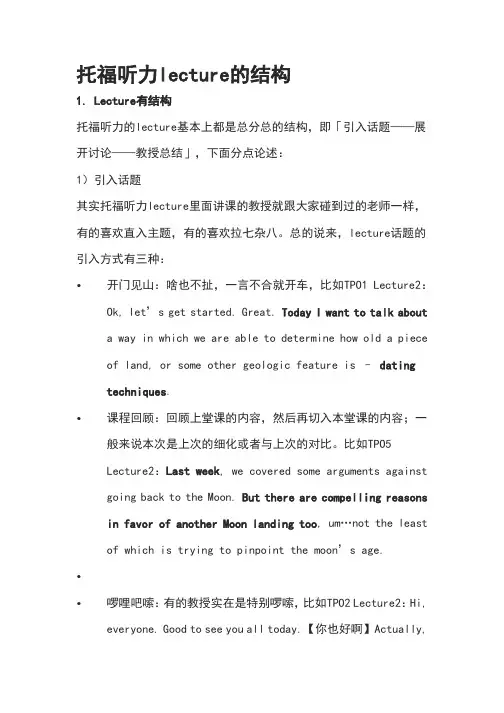
托福听力lecture的结构1. Lecture有结构托福听力的lecture基本上都是总分总的结构,即「引入话题——展开讨论——教授总结」,下面分点论述:1)引入话题其实托福听力lecture里面讲课的教授就跟大家碰到过的老师一样,有的喜欢直入主题,有的喜欢拉七杂八。
总的说来,lecture话题的引入方式有三种:•开门见山:啥也不扯,一言不合就开车,比如TPO1 Lecture2:Ok, let’s get started. Great. Today I want to talk abouta way in which we are able to determine how old a pieceof land, or some other geologic feature is –datingtechniques.•课程回顾:回顾上堂课的内容,然后再切入本堂课的内容;一般来说本次是上次的细化或者与上次的对比。
比如TPO5Lecture2:Last week, we covered some arguments against going back to the Moon. But there are compelling reasons in favor of another Moon landing too, um…not the least of which is trying to pinpoint the moon’s age.••啰哩吧嗦:有的教授实在是特别啰嗦,比如TPO2 Lecture2:Hi, everyone. Good to see you all today.【你也好啊】Actually,I expected the population to be a lot lower today. Ittypically runs between 50 and 60 percent on the day theresearch paper is due.【来的人多不好么,说明你受欢迎啊】Um, I was hoping to have your exams back today【啊,要放榜啦】, but, uh, the situation was that I went away forthe weekend, and I was supposed to get in yesterday at five, and I expected to fully complete all the exams by midnightor so, which is the time that I usually go to bed, but myflight was delayed, and I ended up not getting in untilone o’clock in the morning【你飞机晚点关我什么事啊】.Anyway, I’ll do my b est to have them finished by the nexttime we meet【开始上课吧,please】. OK. In the last class,we started talking about...【终于开始了…】不论是用哪一种引入方式,话题总是要出来的。
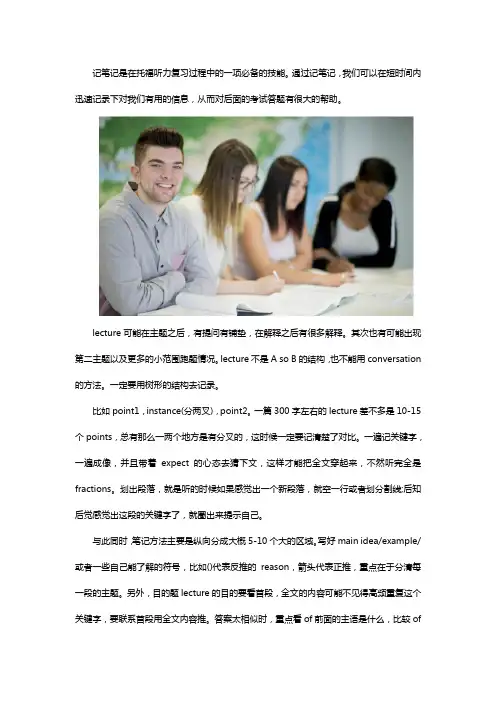
记笔记是在托福听力复习过程中的一项必备的技能。
通过记笔记,我们可以在短时间内迅速记录下对我们有用的信息,从而对后面的考试答题有很大的帮助。
lecture可能在主题之后,有提问有铺垫,在解释之后有很多解释。
其次也有可能出现第二主题以及更多的小范围跑题情况。
lecture不是A so B的结构,也不能用conversation 的方法。
一定要用树形的结构去记录。
比如point1,instance(分两叉),point2。
一篇300字左右的lecture差不多是10-15个points,总有那么一两个地方是有分叉的,这时候一定要记清楚了对比。
一遍记关键字,一遍成像,并且带着expect的心态去猜下文,这样才能把全文穿起来,不然听完全是fractions。
划出段落,就是听的时候如果感觉出一个新段落,就空一行或者划分割线;后知后觉感觉出这段的关键字了,就圈出来提示自己。
与此同时,笔记方法主要是纵向分成大概5-10个大的区域。
写好main idea/example/或者一些自己能了解的符号,比如()代表反推的reason,箭头代表正推,重点在于分清每一段的主题。
另外,目的题lecture的目的要看首段,全文的内容可能不见得高频重复这个关键字,要联系首段用全文内容推。
答案太相似时,重点看of前面的主语是什么,比较of前面的会好点。
其一般是在第二三句的样子,都不是第一句。
purpose题(why prof mention/say。
)区分段落的重要性就在这里,全记的话,在笔记里能定位这个被mention 的东西(当然应该也记住了有印象)如果几个选项觉得都不对,那就需要看笔记了,选占的篇幅比较大的那个。
细节题(what does prof say/imply)直接从笔记里找。
以上就是相关内容介绍,仅供广大需要人士进行参考与采纳。
同时,若您还想了解更多相关资讯,您还可以直接致电或是登录南京市新航道培训中心官网,即可知晓更多详细信息!。
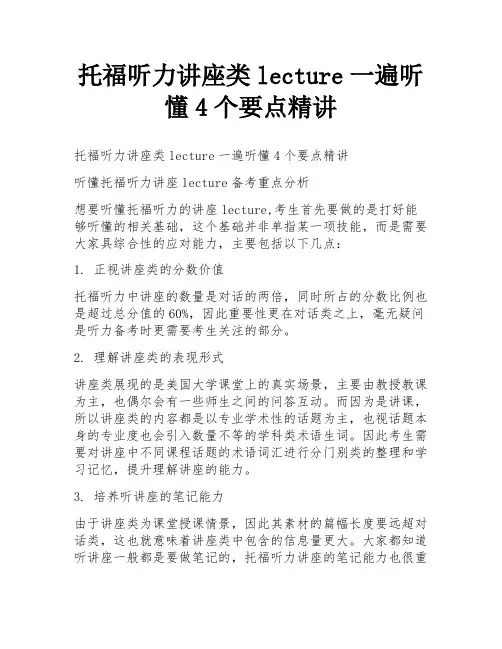
托福听力讲座类lecture一遍听懂4个要点精讲托福听力讲座类lecture一遍听懂4个要点精讲听懂托福听力讲座lecture备考重点分析想要听懂托福听力的讲座lecture,考生首先要做的是打好能够听懂的相关基础,这个基础并非单指某一项技能,而是需要大家具综合性的应对能力,主要包括以下几点:1. 正视讲座类的分数价值托福听力中讲座的数量是对话的两倍,同时所占的分数比例也是超过总分值的60%,因此重要性更在对话类之上,毫无疑问是听力备考时更需要考生关注的部分。
2. 理解讲座类的表现形式讲座类展现的是美国大学课堂上的真实场景,主要由教授教课为主,也偶尔会有一些师生之间的问答互动。
而因为是讲课,所以讲座类的内容都是以专业学术性的话题为主,也视话题本身的专业度也会引入数量不等的学科类术语生词。
因此考生需要对讲座中不同课程话题的术语词汇进行分门别类的整理和学习记忆,提升理解讲座的能力。
3. 培养听讲座的笔记能力由于讲座类为课堂授课情景,因此其素材的篇幅长度要远超对话类,这也就意味着讲座类中包含的信息量更大。
大家都知道听讲座一般都是要做笔记的,托福听力讲座的笔记能力也很重要。
大家在备考时需注意培养边听边记的做笔记能力和习惯,以避免遗漏可能成为出题点的细节信息。
托福听力讲座一遍听懂要点讲解想要做到托福听力讲座一遍就能听懂,下面这4个要点大家需要做好:1. 听懂开头抓主题首先,大家需要在开头部分就集中精力听懂这段课程的主讲话题。
这一点并不难做到,因为一般来说大家听讲座刚开始注意力都是相对集中的。
而讲座类听力在正式开始前也会给出一个简单的提示介绍告诉你这篇听力素材的大致学科方向。
同时讲座类听力基本上也都是开门见山上来就会讲主题,所以听懂开头抓住主题并非难事。
2. 主动预测后续内容抓住主题不难,但抓住主题之后还需要做什么就很关键了。
不少同学听不懂讲座内容,问题在于缺乏积极主动性,始终在被动接受信息听到什么记什么,而没有主动去思考后面可能会讲什么。
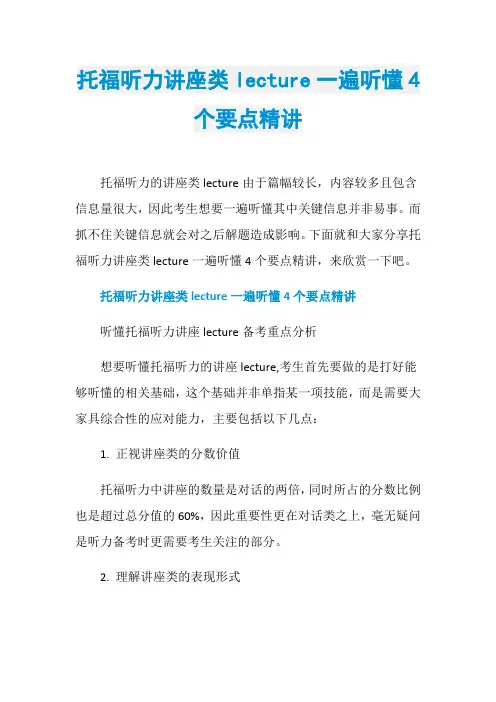
托福听力讲座类lecture一遍听懂4个要点精讲托福听力的讲座类lecture由于篇幅较长,内容较多且包含信息量很大,因此考生想要一遍听懂其中关键信息并非易事。
而抓不住关键信息就会对之后解题造成影响。
下面就和大家分享托福听力讲座类lecture一遍听懂4个要点精讲,来欣赏一下吧。
托福听力讲座类lecture一遍听懂4个要点精讲听懂托福听力讲座lecture备考重点分析想要听懂托福听力的讲座lecture,考生首先要做的是打好能够听懂的相关基础,这个基础并非单指某一项技能,而是需要大家具综合性的应对能力,主要包括以下几点:1. 正视讲座类的分数价值托福听力中讲座的数量是对话的两倍,同时所占的分数比例也是超过总分值的60%,因此重要性更在对话类之上,毫无疑问是听力备考时更需要考生关注的部分。
2. 理解讲座类的表现形式讲座类展现的是美国大学课堂上的真实场景,主要由教授教课为主,也偶尔会有一些师生之间的问答互动。
而因为是讲课,所以讲座类的内容都是以专业学术性的话题为主,也视话题本身的专业度也会引入数量不等的学科类术语生词。
因此考生需要对讲座中不同课程话题的术语词汇进行分门别类的整理和学习记忆,提升理解讲座的能力。
3. 培养听讲座的笔记能力由于讲座类为课堂授课情景,因此其素材的篇幅长度要远超对话类,这也就意味着讲座类中包含的信息量更大。
大家都知道听讲座一般都是要做笔记的,托福听力讲座的笔记能力也很重要。
大家在备考时需注意培养边听边记的做笔记能力和习惯,以避免遗漏可能成为出题点的细节信息。
托福听力讲座一遍听懂要点讲解想要做到托福听力讲座一遍就能听懂,下面这4个要点大家需要做好:1. 听懂开头抓主题首先,大家需要在开头部分就集中精力听懂这段课程的主讲话题。
这一点并不难做到,因为一般来说大家听讲座刚开始注意力都是相对集中的。
而讲座类听力在正式开始前也会给出一个简单的提示介绍告诉你这篇听力素材的大致学科方向。
同时讲座类听力基本上也都是开门见山上来就会讲主题,所以听懂开头抓住主题并非难事。
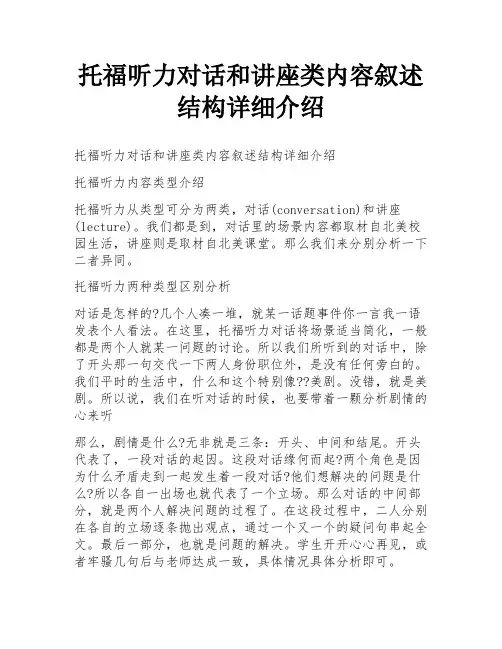
托福听力对话和讲座类内容叙述结构详细介绍托福听力对话和讲座类内容叙述结构详细介绍托福听力内容类型介绍托福听力从类型可分为两类,对话(conversation)和讲座(lecture)。
我们都是到,对话里的场景内容都取材自北美校园生活,讲座则是取材自北美课堂。
那么我们来分别分析一下二者异同。
托福听力两种类型区别分析对话是怎样的?几个人凑一堆,就某一话题事件你一言我一语发表个人看法。
在这里,托福听力对话将场景适当简化,一般都是两个人就某一问题的讨论。
所以我们所听到的对话中,除了开头那一句交代一下两人身份职位外,是没有任何旁白的。
我们平时的生活中,什么和这个特别像??美剧。
没错,就是美剧。
所以说,我们在听对话的时候,也要带着一颗分析剧情的心来听那么,剧情是什么?无非就是三条:开头、中间和结尾。
开头代表了,一段对话的起因。
这段对话缘何而起?两个角色是因为什么矛盾走到一起发生着一段对话?他们想解决的问题是什么?所以各自一出场也就代表了一个立场。
那么对话的中间部分,就是两个人解决问题的过程了。
在这段过程中,二人分别在各自的立场逐条抛出观点,通过一个又一个的疑问句串起全文。
最后一部分,也就是问题的解决。
学生开开心心再见,或者牢骚几句后与老师达成一致,具体情况具体分析即可。
与之相比,讲座则有太大的特色。
讲座作为学术类的选题,内容的展开其实与说明文超级相似,都是各种总分。
文章提出一个总的中心关键词,每一个段落再提出一个其下的子类别关键词,分别都遵循着“专有名词提出、解释说明、举例或详解”一样的套路。
考生了解听力结构有什么用?如果是大神级考生,基本大部分内容都可以无伤理解,那么在结构上多投入精力会帮助你大幅提高理解文章的能力,甚至预测下文都不在话下。
但如果基础相对薄弱,在背单词和听写提高基本理解的同时,那么把握文章基本段落结构也是帮助大家理清思路的有力武器!托福听力练习对照文本So, uh . . . as Jim said, James Polk was the eleventh President, and . . . uh . . . well, my report's about the next President—Zachary Taylor. Taylor was elected in 1849.那么,呃……就像Jim所说,James Polk曾经是第十一任总统,并且……呃……好,我的报告是关于下任总统-- Zachary Taylor。
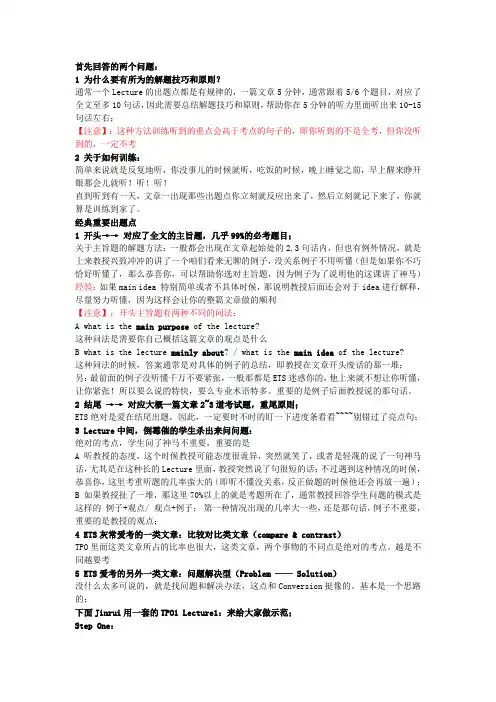
首先回答的两个问题:1 为什么要有所为的解题技巧和原则?通常一个Lecture的出题点都是有规律的,一篇文章5分钟,通常跟着5/6个题目,对应了全文至多10句话,因此需要总结解题技巧和原则,帮助你在5分钟的听力里面听出来10-15句话左右;【注意】:这种方法训练听到的重点会高于考点的句子的,即你听到的不是全考,但你没听到的,一定不考2 关于如何训练:简单来说就是反复地听,你没事儿的时候就听,吃饭的时候,晚上睡觉之前,早上醒来睁开眼那会儿就听!听!听!直到听到有一天,文章一出现那些出题点你立刻就反应出来了,然后立刻就记下来了,你就算是训练到家了。
经典重要出题点1 开头→→ 对应了全文的主旨题,几乎99%的必考题目;关于主旨题的解题方法:一般都会出现在文章起始处的2,3句话内,但也有例外情况,就是上来教授兴致冲冲的讲了一个咱们看来无聊的例子,没关系例子不用听懂(但是如果你不巧恰好听懂了,那么恭喜你,可以帮助你选对主旨题,因为例子为了说明他的这课讲了神马)经验:如果main idea 特别简单或者不具体时候,那说明教授后面还会对于idea进行解释,尽量努力听懂,因为这样会让你的整篇文章做的顺利【注意】:开头主旨题有两种不同的问法:A what is the main purpose of the lecture?这种问法是需要你自己概括这篇文章的观点是什么B what is the lecture mainly about? / what is the main idea of the lecture?这种问法的时候,答案通常是对具体的例子的总结,即教授在文章开头废话的那一堆;另:最前面的例子没听懂千万不要紧张,一般那都是ETS迷惑你的,他上来就不想让你听懂,让你紧张!所以要么说的特快,要么专业术语特多。
重要的是例子后面教授说的那句话。
2 结尾→→ 对应大概一篇文章2~3道考试题,重尾原则;ETS绝对是爱在结尾出题,因此,一定要时不时的盯一下进度条看看~~~~别错过了亮点句;3 Lecture中间,倒霉催的学生杀出来问问题:绝对的考点,学生问了神马不重要,重要的是A 听教授的态度,这个时候教授可能态度很诡异,突然就笑了,或者是轻蔑的说了一句神马话,尤其是在这种长的Lecture里面,教授突然说了句很短的话;不过遇到这种情况的时候,恭喜你,这里考重听题的几率蛮大的(即听不懂没关系,反正做题的时候他还会再放一遍);B 如果教授扯了一堆,那这里70%以上的就是考题所在了,通常教授回答学生问题的模式是这样的例子+观点/ 观点+例子;第一种情况出现的几率大一些,还是那句话,例子不重要,重要的是教授的观点;4 ETS灰常爱考的一类文章:比较对比类文章(compare & contrast)TPO里面这类文章所占的比率也很大,这类文章,两个事物的不同点是绝对的考点。
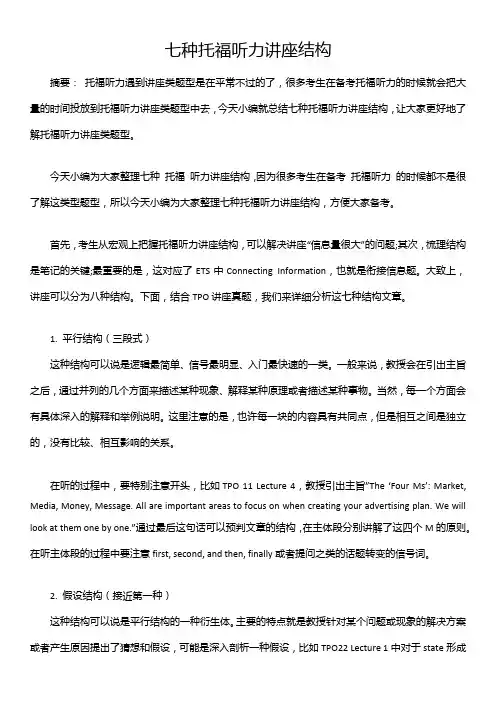
七种托福听力讲座结构摘要:托福听力遇到讲座类题型是在平常不过的了,很多考生在备考托福听力的时候就会把大量的时间投放到托福听力讲座类题型中去,今天小编就总结七种托福听力讲座结构,让大家更好地了解托福听力讲座类题型。
今天小编为大家整理七种托福听力讲座结构,因为很多考生在备考托福听力的时候都不是很了解这类型题型,所以今天小编为大家整理七种托福听力讲座结构,方便大家备考。
首先,考生从宏观上把握托福听力讲座结构,可以解决讲座“信息量很大”的问题;其次,梳理结构是笔记的关键;最重要的是,这对应了ETS中Connecting Information,也就是衔接信息题。
大致上,讲座可以分为八种结构。
下面,结合TPO讲座真题,我们来详细分析这七种结构文章。
1. 平行结构(三段式)这种结构可以说是逻辑最简单、信号最明显、入门最快速的一类。
一般来说,教授会在引出主旨之后,通过并列的几个方面来描述某种现象、解释某种原理或者描述某种事物。
当然,每一个方面会有具体深入的解释和举例说明。
这里注意的是,也许每一块的内容具有共同点,但是相互之间是独立的,没有比较、相互影响的关系。
在听的过程中,要特别注意开头,比如TPO 11 Lecture 4,教授引出主旨”The ‘Four Ms’: Market, Media, Money, Message. All are important areas to focus on when creating your advertising plan. We will look at them one b y one.”通过最后这句话可以预判文章的结构,在主体段分别讲解了这四个M的原则。
在听主体段的过程中要注意first, second, and then, finally或者提问之类的话题转变的信号词。
2. 假设结构(接近第一种)这种结构可以说是平行结构的一种衍生体。
主要的特点就是教授针对某个问题或现象的解决方案或者产生原因提出了猜想和假设,可能是深入剖析一种假设,比如TPO22 Lecture 1中对于state形成原因是environmental approach的分析;也可能是同时提出了几种假设,比如TPO 22 Lecture 2中young sun paradox的几种solution猜想。
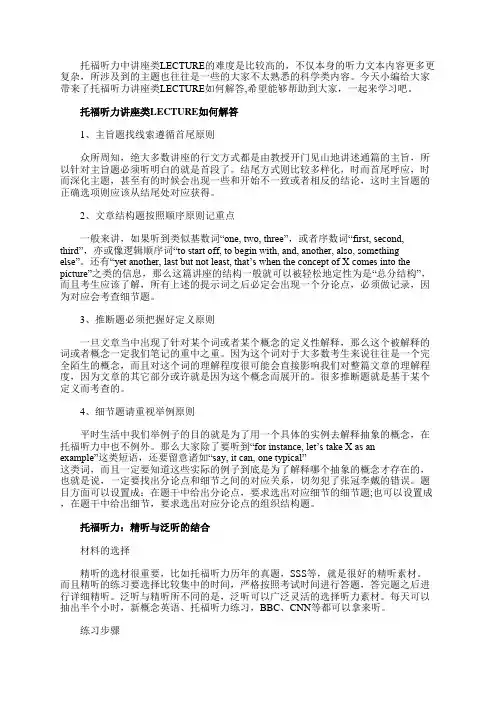
托福听力中讲座类LECTURE的难度是比较高的,不仅本身的听力文本内容更多更复杂,所涉及到的主题也往往是一些的大家不太熟悉的科学类内容。
今天小编给大家带来了托福听力讲座类LECTURE如何解答,希望能够帮助到大家,一起来学习吧。
托福听力讲座类LECTURE如何解答1、主旨题找线索遵循首尾原则众所周知,绝大多数讲座的行文方式都是由教授开门见山地讲述通篇的主旨,所以针对主旨题必须听明白的就是首段了。
结尾方式则比较多样化,时而首尾呼应,时而深化主题,甚至有的时候会出现一些和开始不一致或者相反的结论,这时主旨题的正确选项则应该从结尾处对应获得。
2、文章结构题按照顺序原则记重点一般来讲,如果听到类似基数词“one, two, three”,或者序数词“first, second, third”,亦或像逻辑顺序词“to start off, to begin with, and, another, a lso, something else”。
还有“yet another, last but not least, that’s when the concept of X comes into the picture”之类的信息,那么这篇讲座的结构一般就可以被轻松地定性为是“总分结构”,而且考生应该了解,所有上述的提示词之后必定会出现一个分论点,必须做记录,因为对应会考查细节题。
3、推断题必须把握好定义原则一旦文章当中出现了针对某个词或者某个概念的定义性解释,那么这个被解释的词或者概念一定我们笔记的重中之重。
因为这个词对于大多数考生来说往往是一个完全陌生的概念,而且对这个词的理解程度很可能会直接影响我们对整篇文章的理解程度,因为文章的其它部分或许就是因为这个概念而展开的。
很多推断题就是基于某个定义而考查的。
4、细节题请重视举例原则平时生活中我们举例子的目的就是为了用一个具体的实例去解释抽象的概念,在托福听力中也不例外。
干货_深度解析托福听力文章结构托福听力考试主要考查两个模块——对话(conversation)和讲座(lecture)。
对话主要是以学生为主体,以老师(professor)或者教职员工(staff/faculty/employee)为说话对象进行的时长三分钟的校园场景内容。
而讲座主要是时长五分钟的各种科学性文章。
今天小编就和大家介绍一下听力文章的结构!~~干货|深度解析托福听力文章结构对话结构对话部分,常见的文章结构模式为,出现一个问题。
比如说图书馆里要借书但是找不到,比如说学期论文要找个主题找不到,比如说要去报告一下宿舍的空调需要维修等。
那么接下来肯定会提出解决问题的方案,但是前提是对话的时长通常为3分钟左右,所以老师或者教职员工肯定不会很直接地就把这个问题给解决了。
试想,图书管理员把书找给了学生,那么这个对话接下来的故事情节只能是Thank you, bye了。
所以,总结起来,对话的文章结构一般分成四个步骤:1. problem, 即学生出现一个问题;2. solutions, 老师提出一些问题的解决方案,通常这部分的内容会出现好几个解决方案;3. result, 问题的处理结果;4. development, 跟话题本身相关的内容扩展延伸。
讲座结构:平级并列类顾名思义,这种结构通常是很明显的,也是相对来说最简单的一种,不管考生听力能力好坏,或多或少都是能把握的。
比如TPO 41 Lecture 1, 这是一篇botany的讲座文章,主题是在讲Different ways that plants have adapted to desert environments.主旨以外全篇文章分成了三段话,分别讲了三种植物——succulent plant、drought-tolerant plant、annual plant这三段话。
原文是这样说的:Many different species have developed each of the adaptations. So, first off, there are succulent plants…now, besides succulent plants, there’re also drought-tolerant plants…the third adaptive strategy is to avoid the drought conditions altogether. Yes! There are plants that do this: annual plants!2. What are two features of succulent plants that help them survive in deserts?3. Why does the professor mention bears?4. What is one ability that drought-tolerant plants have that succulent plants do not have?5. Why can annual plants grow in a desert even after a year of no rainfall?以上是这篇文章所对应的题目,从出题的角度来讲,这篇平级并列就是考到了文章中讲到的三种植物succulent plant、drought-tolerant plant、annual plant,每个段落考一种。
托福听力讲座类lecture7大常见叙述结构逐一盘点托福听力讲座类在听素材时,考生常会犯的错误是没能记住关键信息。
其实这也可以理解,究竟讲座素材无论是篇幅长度还是包含信息都是相当多的,考生很简单遗漏部分内容。
下面就给大家带来托福听力讲座类lecture7大常见叙述结构逐一盘点,盼望能够关心到大家,一起来学习吧。
托福听力讲座类lecture7大常见叙述结构逐一盘点托福听力讲座类叙述结构:平行结构这种结构可以说是规律最简洁、信号最明显、入门最快速的一类。
一般来说,教授会在引出主旨之后,通过并列的几个方面来描述某种现象、解释某种原理或者描述某种事物。
当然,每一个方面会有详细深化的解释和举例说明。
这里留意的是,或许每一块的内容具有共同点,但是相互之间是独立的,没有比较、相互影响的关系。
在听的过程中,要特殊留意开头,比如托福官方模考套题11 Lecture 4,教授引出主旨”The ‘Four Ms’: Market, Media, Money, Message. All are important areas to focus on when creating your advertising plan. We will look at them one by one.”通过最终这句话可以预判文章的结构,在主体段分别讲解了这四个M的原则。
在听主体段的过程中要留意first, second, and then, finally或者提问之类的话题转变的信号词。
托福听力讲座类叙述结构:假设结构这种结构可以说是平行结构的一种衍生体。
主要的特点就是教授针对某个问题或现象的解决方案或者产生缘由提出了猜想和假设,可能是深化剖析一种假设,比如托福官方模考套题22 Lecture 1中对于state形成缘由是environmental approach的分析;也可能是同时提出了几种假设,比如托福官方模考套题22 Lecture 2中young sun paradox的几种solution猜想。
托福听力讲座lecture题型基础常识考点细节汇总讲解托福听力讲座lecture题型基础常识考点细节汇总讲解托福听力讲座类常考学科介绍托福听力讲座场景官方指南给出46个学科,实际上讲座内容多学科交叉出现的趋势越来越明显,艺术学、生命科学、天文学比、历史较常考。
新托福听力考试讲座部分则是还原真实上课情景,内容都牵涉到了各个学科,文理兼备。
如生物学、地理学、地质学、天文学、环境、文学、艺术、人类学等等。
托福听力讲座类需要背景知识积累吗?有关的这些内容中,有许多考生陌生的单词以及知识点,但考试根本不要求大家具备相应的背景知识,掌握了基本的单词和表达方式就能理解文章大意。
通常关键的术语都会在文章里用各种方式出现相应的解释。
但必须要注意在平日里积累更多方面的课外知识无疑能对做题会很有好处。
托福听力讲座类考查内容分析托福听力的讲座部分模拟的是在英语课堂上上课的情景,由于讲座经常涉及专业知识,所以难度比对话部分要大。
从考查内容来说,讲座部分的取材主要是来自于以下四类学科:文学艺术、生命科学、物理科学和社会科学。
考生可以通过分类练习大量真题来熟悉和掌握常考的话题,并从中学习与这四类学科常相关的高频词汇。
从内容来看,讲座大致有五种类型,分别是概念描述类、问题解答类、理论演变类、对比类和时间顺序类。
每一种类型都有各自的考查重点。
托福听力讲座类题型构成一览每一个讲座之后会出现六道题。
和对话部分一样,讲座部分通常会有一道题是主旨题,考查讲座的主要目的和内容;还有一道题是重听题,考查教授或者学生为什么说某一句话;中间的四道题通常为细节题,一般考查讲座中多次重复并解释的概念、教授举例的目的、教授和学生的互动以及教授的最后总结。
托福备考之独立写作满分范文task:Some people believe that university students should be required to attend classes. Others believe that going to classes should be optional for students. Which point of view do you agree with? Use specific reasons and details to explain your answer.托福备考之独立写作满分范文:Class Attendance Should Not Be CompulsoryIt is undoubtedly true that students should take their studies seriously. This means not only doing the required work, but also actively pursuing every opportunity to learn. So of course they should attend their classes to receive the maximum benefit. However, I do not believe that there is a need to make class attendance mandatory at the university level.By the time they reach university, students are no longer children. They are young adults and should be able to take responsibility for their actions. Attending their classes is of benefit to them, and while it may be tempting to skip them once in a while, it is not the responsible choice. Adults must be able to manage their time on their own and to make their own decisions. If a student misses too many classes and so does poorly in a course, he will have to accept the consequences and learn from his mistake. Finally, non-compulsory class attendance may not only lead to improvements in the students, but also in the teaching. Of course, every professor likes to see full attendance at his classes. If students are not coming to class, the professor should ask himself why. Perhaps the students do not understand the relevance of the material to their studies.In conclusion, I believe that class attendance should not berequired for university students. They should learn to make the right decisions for themselves, and this is one way to encourage the development of independence and responsibility.托福备考之独立写作满分范文task:Do you agree or disagree with the following statement? Television has destroyed communication among friends and family. Use specific reasons and examples to support your opinion.托福备考之独立写作满分范文:The Effects of Television on CommunicationThere is no doubt that television has greatly changed people’s lives. After its invention, it became an almost indispensable part of most households within the space of just a few years. Nowadays, many families have two or even three television sets so that every member of the family can watch what he wants whenever he wants. In my opinion, this has significantly reduced the amount of time that family and friends spend communicating with each other.Before the invention of television, people spent their leisure time in more active and social pursuits. They often played cards or other games, listened to the radio together or went out to see friends. But now television is widely available and it offers a variety of program choices that appeal to almost every interest. People no longer have to look to others for entertainment. Also, television can be like a sedative. Studies have shown that watching a great deal of television makes people more passive. Finally, people are simply watching increasing amounts of television. And with two or three TV sets in the house, there is no need for them to even watch it together.Although television has reduced the amount of time thatfamily and f riends spend together, it doesn’t have to be this way. People can make the choice to turn off the TV and do something more active. Or, if they really want to watch TV, they can find a thought-provoking program that they would all like to watch and discuss afterwards.托福备考之独立写作满分范文A job with more vacation time but a low salary is better than a job with a highsalary but less vacation time.是否同意低薪假期多的工作比高薪假期少的工作好?题目解析:对比类写法主题观点:支持高薪假期少的工作【思路拓展】1.工作是生活的重要部分,因此是幸福的源泉,很多人将自己的成就感和薪水的高低联系到一起。
托福听力l e c t u r e的结构托福听力lecture的结构1. Lecture有结构托福听力的lecture基本上都是总分总的结构,即「引入话题——展开讨论——教授总结」,下面分点论述:1)引入话题其实托福听力lecture里面讲课的教授就跟大家碰到过的老师一样,有的喜欢直入主题,有的喜欢拉七杂八。
总的说来,lecture话题的引入方式有三种:•开门见山:啥也不扯,一言不合就开车,比如TPO1 Lecture2:Ok, let’s get started. Great. Today I want to talk about a way inwhich we are able to determine how old a piece of land, or some other geologic feature is –dating techniques.•课程回顾:回顾上堂课的内容,然后再切入本堂课的内容;一般来说本次是上次的细化或者与上次的对比。
比如TPO5Lecture2:Last week, we covered some arguments against goingback to the Moon. But there are compelling reasons in favor ofanother Moon landing too, um…not the least of which is tryingto pinpoint the moon’s age.••啰哩吧嗦:有的教授实在是特别啰嗦,比如TPO2 Lecture2:Hi, everyone. Good to see you all today.【你也好啊】Actually, Iexpected the population to be a lot lower today. It typically runsbetween 50 and 60 percent on the day the research paper is due.【来的人多不好么,说明你受欢迎啊】 Um, I was hoping tohave your exams back today【啊,要放榜啦?】, but, uh, thesituation was that I went away for the weekend, and I wassupposed to get in yesterday at five, and I expected to fullycomplete all the exams by midnight or so, which is the time thatI usually go to bed, but my flight was delayed, and I ended upnot getting in until one o’clock in the morning【你飞机晚点关我什么事啊?】. Anyway, I’ll do my best to have them finished by the next time we meet【开始上课吧,please】. OK. In thelast class, we started talking about...【终于开始了…】不论是用哪一种引入方式,话题总是要出来的。
一般都有一个核心的话题词,这个词后面一般有一个定义或者解释。
比如TPO5 Lecture3:...But, let’s talk about Spectroscopy a little now just to cover the basics. What is Spectroscopy? Well, the simplest definition I can give you is that Spectroscopy is the study of the interaction between matter and light. 这个「topic+definition/explanation」一定要听懂,最好还能在笔记上记下关键词。
(当然,也有话题词不那么明显的,这样的lecture的结构就稍微难以整理一点。
)在这个「topic+definition/explanation」之后,一般有一句话总起下面的展开讨论的内容。
比如TPO33 Lecture1:The great pyramid of Giza in Egypt might be the most famous building in the world. Weknow exactly when it was built: construction started in 2547 B.C.E., about four thousand five hundred years ago. We know who had it built: that was a Pharaoh Khufu. And we know who oversaw its construction: the Pharaoh's brother. We know so many things about it, but the funny thing is, we still don't know exactly how it was built. This picture will give you an idea of the size of the pyramid and the size of blocks it's made up of. About two million stone blocks were used to build the great pyramid, and they're incredibly massive. The average weight is two and a half tons. The problem that has puzzled scholars for centuries is how were these blocks lifted up the height of this massive structure and then fit into place and without the benefit of modern technology. Of course there have been a lot of theories over the centuries.其实这就是常见的总起句式「several theories」「a few problems」「scientists have proposed several explanations」,下面的展开讨论部分就是具体展开这些theories、problems或explanations。
小结一下:Lecture的第一个部分包括:引入+话题+定义/解释+总起。
2)展开讨论展开讨论当然紧接着上面的总起,结构往往比较清晰。
比如TPO33 Lecture1在总起「Of course there have been a lot of theories over the centuries」之后就逐个展开这些theories。
这些theories都是解释上面的话题,先提出theory1,讲清楚后再讲theory1的问题;因为theory1有问题,自然就转入了theory2,再以此类推讲theory3、theory4——一般也就是三个或四个theory,再多就太长了。
•The oldest recorded one 【theory1】 is by the Greek historian Herodotus...Well, so much for that theory.•The next one【theory2】has to do with the use of a ramp...【theory2的问题】OK, so what now?•Well, if you'd ever driven on a mountain road...So why not wrap the ramp around the pyramid【theory3】... Well, if you've got aramp spiraling up from the base of the pyramid, those cornerswould be buried by that ramp during construction【theory3的问题】.•Well, who says the ramp has to be on the outside of the pyramid?And now we get to the latest idea【theory4】: if the ramp were on the inside of the pyramid...其实这种就是托福听力lecture的第一种,即「总分总」的多个「分点」之间是并列的关系,比较常见的是「problem+solution1、solution2、solution3」或者「puzzle+explanation1、explanation2、explanation3」。
不论是一个问题+多个解决方案,还是一个疑难+多种解释,不论具体的用词是用solution、explanation还是theory,总体结构都是类似的。
这些结构大多适用于理工科的话题,逻辑比较清晰,转进的逻辑连接词也很明确,占据托福听力lecture的大多数。
另外一种就是「总分总」的多个「分点」之间是直线型的时间关系,多适用于文科的内容。
比如讲到某个作家的生平,一般都是「早年——青年——中年——晚年」,再比如讲到某种乐器的进化史,一般都是「起源——19世纪——20世纪——21世纪」之类的。
比如TPO30 Lecture4:话题引入之后总起But really the instrument [electric guitar] we know today was the result of a continuing development that started for our practical purposes in the 1920s. 然后就分阶段讲述guitar的发展史:•The first guitars were wooden...•the steel guitar was first introduced in the United States...in the late 1890s...•Anyway, by the 1920s...•Electrified guitars... around 1940...很显然,这种直线型结构的关键在于听懂记下这些时间标记。